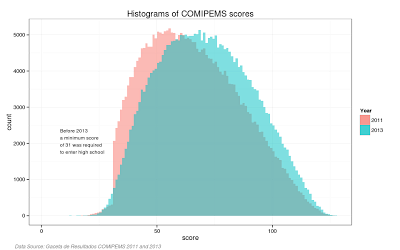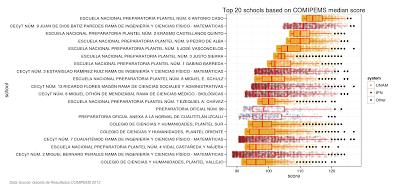 |
| Click on the map to visit the interactive version |
- Before the test students must rank up to 20 schools in order of preference.
- All high schools rank the students based solely on the score each students gets in the COMIPEMS exam, preferring students who score higher (no allowance is made for different skill categories, well, except for the UNAM and IPN which also requires a GPA of at least 70%).
- After the test are graded a computer orders the students by test score and proposes to match each student with his first school choice. If the student has the required GPA and the school he proposed to hasn’t filled up then he is accepted. In a second step each student who has been rejected proposes to their next school choice. Each school that still has free space then considers the students until they reach capacity and so on until all student choices are exhausted.
There isn’t a lot of information on how the COMIPEMS handles ties,
In 2013 out of 310,163 student who registered for the test, 280,096 showed up, out of those, 33,695 (12.0%) were not admitted to any school because of the limited number of options they specified. But they can always apply to one of the low quality schools with excess capacity. It would probably be a good idea to encourage students to submit long lists that contain less preferred but still acceptable options.
In fact, the advice given at the COMIPEMS website is wrong (if indeed the admission process follows Gale-Shapley) since it specifically warns students to limit their options in the FAQ:
What is the maximum allowed number of highly demanded schools a student can list?Under Gale-Shapley it is always optimal to list your true order of preferences regardless of whether your options are likely fill up. If Prepa 6 is your true fifth choice then that’s what you should list it as, and if you prefer the CONALEP Neza to not studying high school then that’s what you should list as you twentieth choice.
There isn’t a maximum number of options; however, it is recommended to choose a maximum a four, this is because highly selective schools can fill up quickly and it is very unlikely that you’ll be assigned a place after your fourth option.
¿Cuál es el número máximo de opciones de alta demanda que se puede seleccionar?No existe un número máximo; sin embargo, se recomienda elegir un máximo de cuatro, debido a que estos planteles llenan rápidamente sus lugares disponibles y es poco probable quedar asignado en una opción de alta demanda que se selecciona después de la cuarta preferencia.
It would also probably be a good idea to allow schools to rank students based on different skills, some schools specialize in math, other in verbal skills. Perhaps even give priority to students with a sibling already attending one of their preferred options to make life easier for the parents.
For some reason the 2013 scores went up compared to 2011. Even when taking into account that nowadays high school is mandatory and everyone is guaranteed a place no matter how low their scores. With a guaranteed spot I can see how the big discontinuity at score 31 would disappear in 2013 with some students slacking off since they are now guaranteed a place, but there was also an increase in the right side of the curve, so students this year were overall smarter (an improvement of 7 points is a lot).
| Min. | 1st Qu. | Median | Mean | 3rd Qu. | Max. |
|---|---|---|---|---|---|
| 2.00 | 55.00 | 70.00 | 70.51 | 86.00 | 127.00 |
2011
| Min. | 1st Qu. | Median | Mean | 3rd Qu. | Max. |
|---|---|---|---|---|---|
| 6.00 | 49.00 | 63.00 | 65.32 | 80.00 | 127.00 |
Both the 2011 and 2013 tests had a standard deviation of 20.4
The best public high schools in Mexico City:
With two exceptions, the top spots are schools run by the UNAM or the IPN. I wonder what the Preparatoria Oficial 99 is doing to attract so many smart students? If you look at the map the rest of the zone it is located in (Coacalco) has quite low scores.










